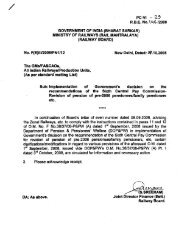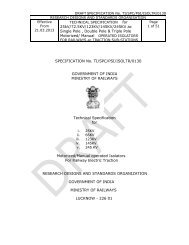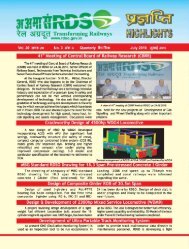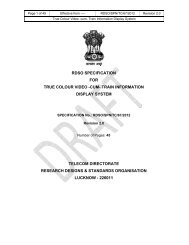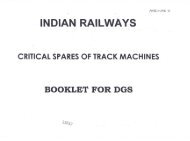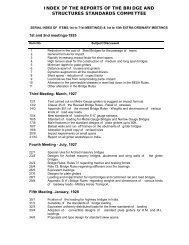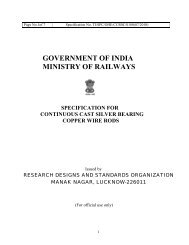Tender invited for Development of Train Collision Avoidance System
Tender invited for Development of Train Collision Avoidance System
Tender invited for Development of Train Collision Avoidance System
Create successful ePaper yourself
Turn your PDF publications into a flip-book with our unique Google optimized e-Paper software.
ISO 9001: 2008 Effective from 18.06.2012 RDSO/SPN/196/2012 Version 3.1.1<br />
Document Title : Specification <strong>of</strong> <strong>Train</strong> <strong>Collision</strong> <strong>Avoidance</strong> <strong>System</strong><br />
that it does not get detached during the run <strong>of</strong> the train.<br />
4.16 All units shall store events essential <strong>for</strong> per<strong>for</strong>mance monitoring and diagnostic<br />
purpose, <strong>for</strong> a period <strong>of</strong> 90 days in Loco unit& 30 days in other units, and<br />
logging <strong>of</strong> last five collision type situations will be stored in central server. It<br />
shall not be possible to interfere with this data by any person. It shall also be<br />
possible to generate print reports based on such stored data using a portable<br />
PC. Event storage equipments shall be <strong>of</strong> rugged design to escape damage<br />
during physical collision. The data logger, as individual, shall have SIL-2 level<br />
<strong>of</strong> safety as per CENELEC or equivalent standards.<br />
4.17 The system shall be compatible & interoperable with the existing TCAS system<br />
on Indian Railways.<br />
4.18 Modes:<br />
The Loco unit shall be able to provide protection to the train in various modes <strong>of</strong><br />
operation depending upon the in<strong>for</strong>mation available to it from station, lineside &<br />
trackside equipments. These are:<br />
4.18.1 Normal Mode – When Loco unit receives all the data, which is required <strong>for</strong><br />
per<strong>for</strong>ming full functionality, it shall switch to Normal mode.<br />
4.18.2 Controlled Mode – Loco unit shall switch to this mode when it is unable to<br />
deduce the correct Track Identification Number. The working in this mode<br />
is defined in Clause 5.17. As soon as TIN is acquired by the Loco unit, it<br />
shall exit from this mode & shall enter into other mode depending upon<br />
other conditions.<br />
4.18.3 Restricted Mode – This mode is entered into by the Loco Pilot or<br />
automatically & it allows the Loco Pilot to move the train under his own<br />
responsibility in a TCAS equipped area under certain situations. However,<br />
it shall monitor the speed <strong>of</strong> the train to a maximum limit <strong>of</strong> 15 KMPH<br />
(configurable in steps <strong>of</strong> from 0 to 30 KMPH in steps <strong>of</strong> 5 KMPH).<br />
4.18.4 Staff Responsible Mode – This mode is entered into by the Loco Pilot it<br />
allows the Loco Pilot to move the train under his own responsibility<br />
4.18.5 Coupled/ Banking operation – This mode shall be entered & exit<br />
manually. This mode shall be entered if the locomotive is not the leading<br />
locomotive. The loco equipment in ‘Coupled/ Banking’ mode shall not apply<br />
any brake. The brake in banking loco shall be applied through its normal<br />
brake system. However, the locomotive in this mode shall carryout all the<br />
functions related with track identification.<br />
4.18.6 Isolation Mode – The Loco unit automatically transitions to this mode<br />
when in standstill condition <strong>of</strong> the locomotive, Isolation switch is operated<br />
by the Loco Pilot to isolate the Brake Interface Unit (BIU) physically from<br />
the brakes. If Isolation switch is operated in running condition <strong>of</strong> the<br />
locomotive, Loco unit shall command the emergency brake till the train<br />
stops & shall then switchover to ‘Isolation Mode’. In this mode, Loco unit<br />
has no role/ responsibility <strong>for</strong> its functionality. However, under this mode<br />
Loco unit shall not affect the normal working <strong>of</strong> locomotive including its<br />
brake system.<br />
4.18.7 Failure Mode – The Loco unit equipment shall switch to this mode, in case<br />
<strong>of</strong> a fault, which affects safety and shall permanently command the<br />
Emergency Brake.<br />
4.18.8 Unfitted Mode – Loco unit shall automatically switch to this mode after<br />
exiting out <strong>of</strong> TCAS territory. In this mode, the Loco unit has no other role/<br />
responsibility <strong>for</strong> its functionality but shall carry out the functions defined in<br />
Clauses 5.10, 5.11, 5.15&5.16.<br />
4.18.9 Reverse Mode – This mode is entered into by the Loco Pilot & permits<br />
movement <strong>of</strong> the train in reverse train direction. The speed <strong>of</strong> the train shall<br />
be supervised against a defined value (programmable, 0 to 30 KMPH in<br />
steps <strong>of</strong> 5 KMPH).<br />
Signal Directorate RDSO/Lucknow Page 14 <strong>of</strong> 56



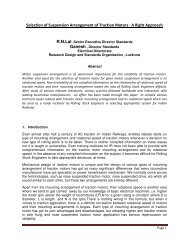

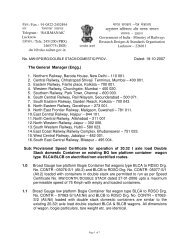
![Hkkjrljdkj] jsy ea= ky; vuql a/ kkuvfHkdYivkSj ekudlax Bu y ... - rdso](https://img.yumpu.com/21978459/1/184x260/hkkjrljdkj-jsy-ea-ky-vuql-a-kkuvfhkdyivksj-ekudlax-bu-y-rdso.jpg?quality=85)

